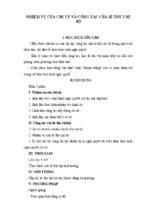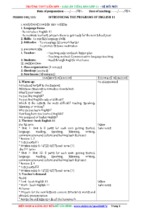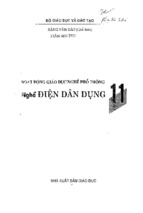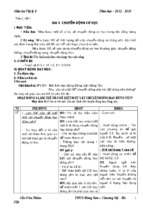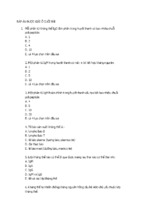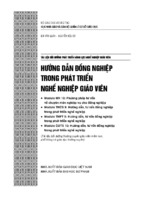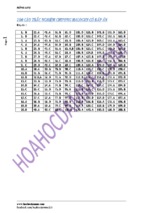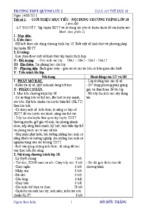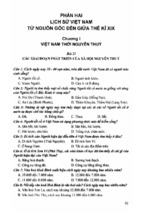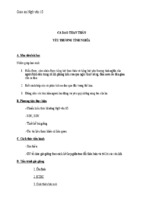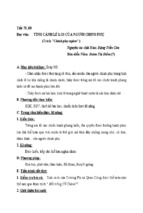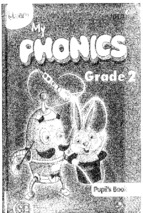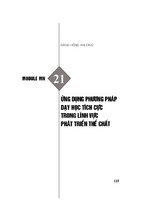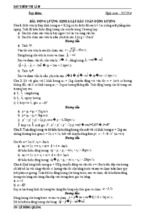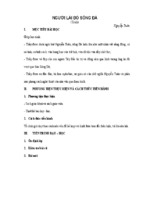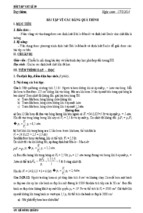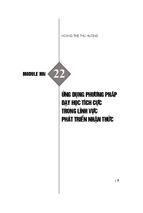đề thi olympic hóa học baltic
XVIII Baltic
Chemistry
Olympiad
Theoretical Problems
with solutions
Code: ....................
1.
2.
3.
4.
5.
6.
Σ
16-18 April 2010
Tartu, Estonia
XVIII Baltic Chemistry Olympiad
Tartu, 16-18 April 2010
Instructions
• Write your code on the first page.
• You have 5 hours to work on the problems. Begin only when
the START command is given.
• All results must be written in the appropriate boxes. Anything
written elsewhere will not be graded. Use the reverse of the
sheets if you need scratch paper.
• Write relevant calculations in the appropriate boxes when
necessary. If you provide only correct end results for
complicated problems, you receive no score.
• You must stop your work immediately when the STOP
command is given. A delay in doing this by 5 minutes may lead
to cancellation of your exam.
• Do not leave your seat until permitted by the supervisors.
• This examination has 23 pages.
• The official English version of this examination is available on
request only for clarification.
Theoretical problems with solutions
2
XVIII Baltic Chemistry Olympiad
Tartu, 16-18 April 2010
Constants and Formulae
Avogadro
constant:
NA = 6.022·1023 mol–1
Ideal gas
equation:
pV = nRT
Gas constant:
R = 8.314 J K–1 mol–1
Gibbs energy:
G = H – TS
Faraday
constant:
F = 96485 C mol–1
o
Δr G O = −RT ln K = −nFEcell
Planck
constant:
h = 6.626·10–34 J s
Nernst
equation:
E = EO +
Speed of
light:
c = 3.000·108 m s–1
Logarithm
ln x = 2.303log x
P
RT
ln ox
zF
Pred
I
Zero of the
Lambert-Beer
A = log 0 = ε cl
273.15 K
Celsius scale:
law:
I
In equilibrium constant calculations all concentrations are
referenced to a standard concentration of 1 mol/dm3. Consider all
gases ideal throughout the exam.
Periodic table with relative atomic masses
1
18
1
2
H
1.008
2
13
14
15
16
17
He
4.003
3
4
5
6
7
8
9
10
Li
Be
B
C
N
O
F
Ne
6.94
9.01
10.81
12.01
14.01
16.00
19.00
20.18
11
12
13
14
15
16
17
18
Al
Si
P
S
Cl
Ar
39.95
Na Mg
22.99
24.30
3
4
5
6
7
8
9
10
11
12
26.98
28.09
30.97
32.06
35.45
19
20
21
22
23
24
25
26
27
28
29
30
31
32
33
34
35
36
Ti
V
Cr
Mn
Fe
Co
Ni
Cu
Zn
As
Se
Br
Kr
50.94
52.00
54.94
55.85
58.93
58.69
63.55
65.38
69.72
72.64
74.92
78.96
79.90
83.80
41
42
43
44
45
46
47
48
49
50
51
52
53
54
Tc
Ru
Rh
Pd
Ag
Cd
In
Sn
Sb
Te
I
Xe
K
39.10
Ca Sc
40.08 44.96 47.87
37
38
39
40
Rb
Sr
Y
Zr
85.47
87.62 88.91 91.22
55
56
Cs
Ba
132.91 137.33
87
88
Fr
Ra
-
-
5771
89103
Nb Mo
Ga Ge
92.91
95.96
-
72
73
74
75
101.07 102.91 106.42 107.87 112.41 114.82 118.71 121.76 127.60 126.90 131.29
76
77
78
79
80
81
82
83
84
85
86
Hf
Ta
W
Re
Os
Ir
Pt
Au
Hg
Tl
Pb
Bi
Po
At
Rn
-
-
-
69
70
178.49 180.95 183.84 186.21 190.23 192.22 195.08 196.97 200.59 204.38 207.2 208.98
104
105
106
107
108
109
110
111
Rf
Db
Sg
Bh
Hs
Mt
Ds
Rg
-
-
-
-
-
-
-
-
60
61
62
63
57
58
59
La
Ce
Pr
Nd Pm Sm Eu
138.91 140.12 140.91 144.24
-
89
90
91
92
93
Ac
Th
Pa
U
Np
-
232.04 231.04 238.03
-
64
65
66
67
68
Gd
Tb
Dy
Ho
Er
Tm Yb
71
Lu
150.36 151.96 157.25 158.93 162.50 164.93 167.26 168.93 173.05 174.97
94
95
96
97
Pu Am Cm Bk
-
Theoretical problems with solutions
-
-
-
98
Cf
-
102
103
Es Fm Md No
99
Lr
-
100
-
101
-
-
3
-
XVIII Baltic Chemistry Olympiad
Tartu, 16-18 April 2010
1. Ethanol as sourse of energy
10 p
Since ancient times ethanol has been used for lamp oil and cooking,
along with plant and animal oils. Nowadays vast majority of ethanol
is used as fuel and is produced in large scale by fermentation, in
which certain species of yeast metabolize sugar producing ethanol.
It can be said that sunlight is used to run the engine of a vehicles,
as a simple sugar is created in the plant by photosynthesis, and
during ethanol combustion carbon dioxide and water are produced
with a release of energy.
a) Write chemical equations for sugar synthesis, ethanol production
and combustion.
+ hν
6CO2 + 6H2O = C6H12O6 + 6O2
C6H12O6 = 2C2H5OH + 2CO2
(+ Q1)
2C2H5OH + 6O2 = 6H2O + 4CO2 (+ Q2)
(overall: hν = Q1(+ Q2)
Early in 1860 Nikolaus August Otto used
ethyl alcohol as a fuel in internal combustion
engine. Today ethanol may be used as a fuel
to power both direct-ethanol fuel cells (DEFC)
and combustion engines. One of the first
DEFC, which schematic diagram is given, was
introduced in the ShellEco-Marathon in 2007.
b) Identify chemical species A–F on figure.
A – C2H5OH
B – O2
C – H+
D – CO2
E – e−
F – H2O
c) From thermodynamic data calculate DEFC
maximal energy conversion efficiency
ratio: η = ∆rG0/∆rH0 (25 °C).1
compound
H2
CO2
H2O
O2
∆H0, kJ mol−1
S0, J mol−1 K−1
C2H5OH C6H12O6
0
0
−394
−286
−278
−1273
205
131
214
70
161
212
Δ c H 0 = ⎡⎣3 ⋅ ( −286 ) + 2 ⋅ ( −394 ) − ( −278 ) ⎤⎦ kJ/mol = −1368 kJ/mol
Δ c S 0 = ⎣⎡3 ⋅ 70 + 2 ⋅ 214 − 161 − 3 ⋅ 205⎦⎤ J/(mol ⋅ K) = −138 J/(mol ⋅ K)
Δ c G 0 = −1368 kJ/mol − 298 K ⋅ ⎣⎡ −0.138 kJ/(mol ⋅ K)⎦⎤ = 1327 kJ/mol
ηDEFC = −1327 kJ/mol −1368 kJ/mol ⋅ 100 = 97%
1
Give all the ansvers with two signifant numbers.
Theoretical problems with solutions
4
XVIII Baltic Chemistry Olympiad
Tartu, 16-18 April 2010
d) For comparison calculate efficiency of combustion engine running
on Otto cycle using equation for maximal efficiency:
η = 1 − 1/r(γ−1), where γ = Cp/CV ≈ 1.4, r is compression ratio
which equals 9 and 12.5 for ethanol and gasoline, respectively.
Assume, that only half of the efficiency is achieved in practice.
(
)
= (1 − 1 12.5
) ⋅ 0.5 ⋅ 100 = 32%
ηethanol = 1 − 1 91.4 − 1 ⋅ 0.5 ⋅ 100 = 29%
ηgasoline
1.4 − 1
There are several unsolved issues concerning DEFC, thus, in
closer perspective it is more promising to convert ethanol into
hydrogen in order to use the latter in typical hydrogen fuel cell.
e) Using given data calculate the maximal energy conversion
efficiency ratio (η = ∆rG0/∆rH0) of the hydrogen fuel cell.
H2 + 0.5O2 = H2O
Δr H 0 = Δ f H 0 (H2O ) = −286 kJ/mol
Δr S 0 = ⎡⎣70 − 131 − 0.5 ⋅ 205⎦⎤ J/(mol ⋅ K) = −163.5 J/(mol ⋅ K)
Δr G 0 = −286 kJ/mol − 298 K ⋅ ⎣⎡ −0.1635 kJ/(mol ⋅ K)⎦⎤ = −237 kJ/mol
ηHFC = −237 kJ/mol −286 kJ/mol ⋅ 100 = 83%
To be realistic, it should be considered that in order to move a
vehicle the electric energy must be converted into mechanical. Let's
assume that conversion efficiency of subsystems are: 90% for
invertor, 90% for motor, and 90% for gas compressor. Overall
conversion efficiency ratio may be compared to energy conversion
efficiency ratio of combustion engine in which chemical energy is
directly converted to mechanical.
f) Estimate overall efficiency of hydrogen vehicle.
ηHV = 0.83 ⋅ 0.93 ⋅ 100 = 60% (for example in Honda FCX Clarity)
g) Name one-two main advantages of i) ethanol over gasoline fuel
in internal combustion engine; ii) fuel cell over internal
combustion engine.
i) lower fuel consumption per km; eliminate pollution caused by
burning fossil fuels; lower CO2 emissions; based on renewable
energy source
ii) higher efficiency; higher reliability (less moving parts etc.);
eliminate pollution caused by burning fossil fuels – less
emissions; very low noise and vibrations.
Theoretical problems with solutions
5
XVIII Baltic Chemistry Olympiad
Tartu, 16-18 April 2010
2. Synthesis and Aquation
of Fluoropentaaquachromium(III) ion2
10 p
5.0 cm3 2.0 M chromium(III) perchlorate and 5.0 cm3 2.0 M
potassium fluoride were brougt together; the solution was boiled
under reflux for 3 hours and cooled to 0 °C, and the precipitate X
was removed. The density of all solutions is 1.1 g/cm3.
a) In the water solution the chromium(III) perchlorate is presented
as aquachromium cation with co-ordination number equal to six.
Write the formula of aquachromium cation and the precipitate X.
aquachromium cation – [Cr(H2O)6]3+ precipitate X – KClO4
b) During the reflux the water in the inner sphere of the complex is
replaced by anion. Write the equation of reaction.
[Cr(H2O)6](ClO4)3 + KF = [Cr(H2O)5F](ClO4)2 + KClO4↓ + H2O
c) The solubility product of the salt X is Ksp = 2.9·10-3 at 0 °C, but
it is possible to dissolve 10.9 g of the salt in 50 g water at
100 °C (ρ = 1.1 g/cm3). Calculate how many grams of salt X did
precipitate during the cooling process.
1
2 mol
1 dm3
138.55 g
3
⋅
⋅
= 1.39 g
m (KClO4 ) = ⋅ 5 cm ⋅
3
3
1
1 mol
1 dm 1000 cm
Ksp = ⎡⎣K + ⎤⎦ ⎡⎣ClO4− ⎤⎦
In pure water solution of KClO4 at 100ºC:
1 mol
1
1.1 g 1000 cm3
⎡⎣K + ⎤⎦ = ⎡⎣ClO4− ⎤⎦ = 10.9 g ⋅
⋅
⋅
⋅
=
138.55 g 50 g 1 cm3
1 dm3
= 1.73 M
2
Ksp = 1.73 = 3.00
L – solubility of the salt
x – concentration of ClO 4− ions from [Cr(H2O)5F](ClO4)2
Ksp = L ( L + x )
x =
2 5 cm3
⋅
⋅ 2 M = 2.0 M
1 10 cm3
5 cm3
⋅2 M = 1 M
10 cm3
KClO4 was dissolved in reaction micture at 100ºC.
Solubilty of KClO4 in reaction mixture at 0ºC:
L = 0.00145 M
0.0029 = L ( L + 2 ) ≈ 2L
3 = L ( L + 2)
2
L = 1.0 M = c (KClO4 ) =
The problem is based on T.W. Swaddle, E.L. King Inorg. Chem. 4 (1965) 532.
Theoretical problems with solutions
6
XVIII Baltic Chemistry Olympiad
Tartu, 16-18 April 2010
1.45 ⋅ 10−3 mol
1 dm3
⋅
⋅
1 dm3
1000 cm3
138.55 g
⋅
= 0.00201 g
1 mol
= 1.39 g − 0.002 g = 1.4 g
m ( dissolved KClO4 ) = 10 cm3 ⋅
m (percipated KClO4 )
Practically all KClO4 was precipitated.
d) The reaction mixture contained various complexes of chromium.
Cation-exchange (contains R-SO3H groups) separation allowed
isolation of hexaaquachromium(III) ions, fluoropentaaquachromium(III) ions, difluorotetraaquachromium(III) ions and
hydrolytic dimers of chromium. During the eluation process the
sample was first taken into the column and afterwards the ions
were eluated out using HClO4 with varing concentration. Identify
to which species the peaks correspond on the chromatogram.
Concentration
6
Sample
0.1 M HClO4
1 M HClO4
5
2 M HClO4
5 M HClO4
2
4
3
3
2
4
1
1
0
0
10
1 – [Cr(H2O)4F2]+
2 – [Cr(H2O)5F]2+
20
30
V eluent / cm 3
40
50
60
3 – [Cr(H2O)6]3+
4 – dimers ([(H2O)5Cr-O-Cr(H2O)5]4+)
Which compound would come out of the column during the
process of taking the sample into the column?
HClO4, percloric acid
The
contents
of
chromium
and
fluoride
in
purified
fluoropentaaquachromium(III) ions was established. 10.0 cm3 of
the sample was first decomposed using the alkaline solution of
hydrogen peroxide. The fluoride ion is liberated and the oxydation
state of chromium changes from III to VI. After that the sample was
divided into two equal parts. First part was acidified using conc. HCl
and then 3 g KI was added. After standing 5 min the solution was
titrated using 18.5 cm3 0.0975 M Na2S2O3. The endpoint was
determined using starch solution. The second part was analysed
using the fluoride ion selective electrode which was calibrated using
solutions with known concentration of F–. The equation of calibration
Theoretical problems with solutions
7
XVIII Baltic Chemistry Olympiad
curve
was
Tartu, 16-18 April 2010
E = 183 mV − 56 mV ⋅ log ⎡⎣F − ⎤⎦ .
The
reading
of
the
voltmeter was 252.6 mV and the final volume of the solution was
10 cm3 after adjusting the pH of the solution to six.
e) Write all the equations of chemial reactions in the analysis
process and calculate the ration of n(F)/n(Cr) in the sample.
2[Cr(H2O)5F]2+ + 3H2O2 + 10OH– = 2CrO 24 − + 2F– + 18H2O
2CrO 24 − + 2H+ = Cr2O 27 − + H2O
Cr2O 27 − + 6I–+ 14H+ = 2Cr3+ + 3I2 + 7H2O
I2 + 2S2O 23 − = 2I– + S4O 26 −
n ( Cr ) =
1 1 2 2
0.0975 mol
⋅ ⋅ ⋅ ⋅ 18.5 cm3 ⋅
= 0.601 mmol
2 3 1 2
1 dm3
⎡⎣F − ⎤⎦ = 10− (252.6 − 183) mV 56 mV = 0.0572 M
n (F ) = 0.0572 M ⋅ 10 cm3 = 0.572 mmol
n (F )
n ( Cr )
=
0.572 mmol
= 0.95
0.601 mmol
The pseudo first order rate coefficient of aquation
fluoropentaaquachromium(III) ion
[Cr(H2O)5F]2+ + H+ + H2O = [Cr(H2O)6]3+ + HF (I)
is
k =
(
2.303 ⎡⎣CrF2 + ⎤⎦ − ⎡⎣CrF2 + ⎤⎦
0
∞
(
)
) log
of
2
⎡⎣CrF2 + ⎤⎦ − ⎡⎣CrF2 + ⎤⎦ ⎡⎣CrF2 + ⎤⎦
0
∞
2+
2+
2+
⎡⎣CrF ⎤⎦ ⎡⎣CrF ⎤⎦ − ⎡⎣CrF ⎤⎦
0
∞
(
)
t ⎡⎣CrF2 + ⎤⎦ + ⎡⎣CrF2 + ⎤⎦
0
∞
2+
−3
where ⎡⎣CrF ⎤⎦ = 5.28 ⋅ 10 M is the starting concentration and
0
⎡⎣CrF ⎤⎦ equilibrium concentration of the complex ion.
∞
f) Calculate the time t (h) needed to aquate 70% of the complex
ion at 77.2 °C if the concentration of hydrogen ions is 0.414 M,
the rate constant is 4.40·10-6 s-1 and equilibrium constant of the
reaction is 0.048. The water is in excess and not included in the
equilibrium constant.
2+
⎡Cr (H O)3 + ⎤ ⎡HF ⎤
2
⎦
6 ⎦ ⎣
K = ⎣
⎡Cr (H2O ) F2 + ⎤ ⎡H+ ⎤
5
⎣
⎦⎣ ⎦
[Cr(H2O)5F]2+ + H+ + H2O = [Cr(H2O)6]3+ + HF
5.28·10-3 M
0.414 M
0
0 (initial)
5.28·10-3 M – x 0.414 M – x
x
x (equil.)
Theoretical problems with solutions
8
XVIII Baltic Chemistry Olympiad
0.048 =
(5.28 ⋅ 10
x2
−3
)
– x ( 0.414 − x )
Tartu, 16-18 April 2010
x = 4.33·10-3 M
⎡⎣CrF2 + ⎤⎦ = (5.28 − 4.33) ⋅ 10−3 M = 9.5 ⋅ 10−4 M
∞
2+
⎡⎣CrF ⎤⎦ = 5.28 ⋅ 10−3 M ⋅ (1 − 0.7 ) = 1.58 ⋅ 10−3 M
2.303 ⋅ 4.33 ⋅ 10−3 M
⋅
t=
4.4 ⋅ 10−6 s−1 (5.28 + 0.95) ⋅ 10−3 M
(5.28 ⋅ 10
⋅ log
−3
M
)
2
− 1.58 ⋅ 10−3 M ⋅ 9.5 ⋅ 10−4 M
5.28 ⋅ 10−3 M ⋅ (1.58 − 0.95) ⋅ 10−3 M
= 91 h
The hydrofluoric acid is weak acid.
g) Calculate pKa(HF) at 25ºC if the equilibrium constant of the
[Cr(H2O)6]3+ + F– =[Cr(H2O)5F]2+ + H2O
(II)
4
reaction is K = 2.1·10 (25 °C) and for the reaction (I) the
reaction enthalpy is –5.41 kJ/mol.
⎛1
Δr H 0
1⎞
ln
K
ln
K
−
=
−
⎜
⎟
2
1
R
⎝ T2 T1 ⎠
−5410 J/mol ⎛ 1
1 ⎞
ln K2 = ln0.048 −
−
⎜
8.314 J/(mol ⋅ K) ⎝ 298 K 350 K ⎟⎠
K2 = 0.0664
ln
K2
Δ H0
=− r
K1
R
⎛1
1⎞
−
⎜
⎟
⎝ T2 T1 ⎠
= −2.712
HF = H+ + F–
Ka = 1/(KIKII) = 7.17·10-4
pKa = –logKa = 3.14
Theoretical problems with solutions
9
XVIII Baltic Chemistry Olympiad
Tartu, 16-18 April 2010
3. Asymmetry without asymmetric center
10 p
Allenes are not only versatile starting materials in organic synthesis
but also present an interesting case of molecular chirality. Since it is
quite difficult to synthesize allenes in stereoselective manner, they
are first obtained as racemic mixture and then resolved into
individual enantiomers. One of the ways of synthesizing allenes in
depicted below.
b)
a)
MeO2C
MeO2CHC C CHCO2Me
A
MeO
OMe
i-
a) Pr2NLi, THF; then addition of
N
N
O
;
Cl
Cl
b)
, Et3N, CH2Cl2, room temperature
a) Identify structure A. Keep in mind that this reaction is not very
efficient and A is only one of few possible products in this
reaction.
A
O
MeO2C
CO2Me
b) Provide the mechanism for conversion of A into an allene.
N
N
Cl
N
O
MeO2 C
OH
CO2 Me
MeO 2C
Cl
CO 2Me
O
MeO2 C
N
Cl
CO2 Me
N
N
RO2 CHC C CHCO 2R
O
CO 2Me
MeO2 C
+
N
N
O
H
One of the methods to produce allenes in pure enantiomeric form
is dynamic resolution of racemic mixtures. The method takes
advantage of quick epimerization and the low solubility of one of the
stereoisomers. Epimerization means interconversion of one
enantiomer into another proceeding through a common
intermediate B (see scheme below). Since all of the compounds are
in the equilibrium, the position of the equilibrium is shifted in the
direction of the less soluble stereoisomer, which is then collected as
a precipitate.
Theoretical problems with solutions
10
XVIII Baltic Chemistry Olympiad
R*O2C
Tartu, 16-18 April 2010
R*O2C
CO2R*
C
B
H
H
C
CO2R*
H
H
diastereomer 1
diastereomer 2
Reaction conditions: room temperature, Et3N (0.05 Eq),
pentane; R* is (-)-menthyl
c) Provide the structure of B.
B
O
RO 2C
H
C
OMe
NEt 3
In order to establish the absolute configuration of the allene X
obtained by dynamic resolution, one can follow a method developed
by Agosta in 1964. To better understand the essence of the method
let us consider all transformations performed on BOTH enantiomers.
The allene ester is first hydrolyzed to dicarboxylic acid and then
in Diels-Alder reaction with cyclopentadiene is transformed into a
mixure of separable products.
a)
b)
R*O2CHC=C=CHCO2R*
HO2CHC=C=CHCO2H
C1-4
Single enantiomer
a) NaOH; b) cyclopentadiene
d) Provide structures for ALL possible adducts with cyclopentadiene
that could be formed from EACH allene enatiomer (C1-4 from one
allene enantiomer, and C5-8 from the other). You are allowed to
use molecular models provided by organizers.
R*O2C
H
H
C
CO2R*
R*O2C
H
H
H
HO2 C
CO2R*
H
H
HO2 C
HO2 C
HO 2C
H
CO2H
C
H
H
CO2 H
H
CO 2H
H
CO 2H
CO2 H
H
H
HO 2C
CO2H
CO2H
H
CO2H
H
H
H
CO2H
C1-4
Theoretical problems with solutions
CO 2H
H
HO2 C
H
C5-8
11
Tartu, 16-18 April 2010
XVIII Baltic Chemistry Olympiad
C1-4
C5-8
Each of the individual compounds C1-8 is then subjected to 2 test
reactions: a) iodolactonization and b) cyclic anhydride formation.
b)
a)
E
D
C
a) I2, NaHCO3; b) acetic anhydride
e) In your list of adducts, identify which structures C1-8 are capable
of giving desired products in BOTH test reactions. Draw equation
for ONE iodolactonization reaction (D) and ONE cyclic anhydride
formation (E).
H
H
CO2 H
H
CO2 H
HO2 C
H
HO2C
H
I
CO2 H
O
O
D
H
H
O
CO2 H
H O
H
CO 2H
C
E
O
The compound(s) C that gives positive result in both test
reactions is (are) then degraded according to the following scheme.
The product of the reaction F (C7H10O) is optically active compound.
a)-d)
C
F
C7H10O
a) Pd/C, H2; b) CH2N2; c) O3; d) HCl, reflux
In summary, the explicit assignment of the absolute
configuration by method of Agosta is based on the fact that one
enantiomer of F can only be produced from (R)-allene, while the
opposite enantiomer of F stems only from the (S)-allene.
Theoretical problems with solutions
12
Tartu, 16-18 April 2010
XVIII Baltic Chemistry Olympiad
f) In aforementioned case of dynamic resolution of allenes the
degradation yields exclusively (1S,4R)-F stereoisomer. Draw the
structure of F.
F
g) Based on the structure of compound (1S,4R)-F and identification
method by Agosta suggest the structure of allene X, which was
obtained by dynamic resolution.
X
HO2 C
C
H
Theoretical problems with solutions
CO2 H
H
13
XVIII Baltic Chemistry Olympiad
4. Environmental hazards
Tartu, 16-18 April 2010
10 p
Around World War II Jinzu River in Toyama prefecture Japan was
contaminated with element X1 compounds and nowadays Japan still
is one of top three producers of this element. Element X1
accumulates in rice and can cause Itai-Itai disease in humans; it
also replaces calcium in bones. This element is produced from
compound A which is its only mineral of practical importance.
Compound A is also a direct band gap semiconductor and has many
applications for example in light detectors and as thermally stable
pigments.
Binary compound A contains also nonmetallic element Y1 and
this compound forms minerals greenockite (first discovered in
Scotland and named after the land owner Lord Greenock) and
hawleyite. The first mineral has hexagonal structure while second
mineral has cubic structure. Mass fraction of X1 in compound A is
77.6%.
Element X1 can be obtained from A by roasting it in air. Obtained
oxide is treated with sulfur trioxide to form X1 sulfate which is
dissolved in water and electrolyzed.
a) Determine element X1, show your calculations!
Metallic elements are usually found in nature as oxygen
containing salts, oxides, sulfides and as free metals. In this case
A is binary compound but it cannot be oxide because then its
oxidation (roasting) stage is irrelevant. Element A could be
sulfide of X1. General formula for sulfides is E2Sn.
2 ⋅ M(X1 )
%(X1 ) =
2 ⋅ M(X1 ) + n ⋅ M(S)
2 ⋅ M(X1 )
0.776 =
2 ⋅ M(X1 ) + n ⋅ 32.07
2 ⋅ M(X1 ) = 1.522 ⋅ M(X1 ) + 24.89 ⋅ n
0.448 ⋅ M(X1 ) = 24.89 ⋅ n
M(X1 ) = 55.6 ⋅ n
if n = ... then
1
2
3
4
5
6
7
8
M(X1) = ... and the element is
55.54
iron, but does not have valence of 1
111.10
cadmium = X1
166.65
erbium, its ions contain f electrons
222.20
radon, does not form sulfides
277.75
hassium, is not occurred in nature
333.30
no such element
388.84
--´´-444.40
--´´--
Theoretical problems with solutions
14
XVIII Baltic Chemistry Olympiad
Tartu, 16-18 April 2010
b) Write equations for all mentioned reactions taking place in
element production!
2CdS + 3O2 = 2SO2 + 2CdO
CdO + SO3 = CdSO4
electrolysis
2CdSO4 + 2H2O ⎯⎯⎯⎯⎯→
2Cd + 2H2SO4 + O2↑
c) Calculate mass of metal X1 which can be obtained by electrolysis
of 0.15 M metal sulfate solution with 0.5 A current and one hour
long.
m=
I ⋅ t ⋅ M 0.5 A ⋅ 3600 s ⋅ 112.41 g/mol
=
= 1.05 g
2 ⋅ 96500 C/mol
z⋅F
d) Write electron formula for element X1 ions in sulfate solution,
knowing that there are no f electrons in this ion.
1s22s22p63s23p64s23d104p64d10
e) Table with lattice parameters for greenockite and hawleyite is
shown bellow. Calculate Z value (number of “molecules” in unit
cell) for hawleyite as well as density for greenockite.
Cell parameters of minerals are given below:
Parameter
Greenockite
Hawleyite
System
hexagonal
cubic
a = b = 3.82 Å
c = 6.26 Å
Parameters
a = 5.818 Å
o
γ = 120 (angle between a
and b)
Z
2
?
Density
?
4.87 g·cm-3
(
V = a3 = 5.818 ⋅ 10−10 m
)
3
(
= 5.818 ⋅ 10−8 cm
)
3
= 1.969 ⋅ 10−22 cm3
Then mass of unit cell:
m = ρ ⋅ V = 4.87 g/cm3 ⋅ 1.969 ⋅ 10−22 cm3 = 9.59 ⋅ 10−22 g
Mass of one “molecule” of CdS is equal to:
M(CdS) (112.4 + 32.07 ) g/mol
m0 =
=
= 2.4 ⋅ 10−22 g
23
NA
6.02 ⋅ 10 1/mol
Z=
9.59 ⋅ 10−22 g
= 3.99 ≅ 4
2.4 ⋅ 10−22 g
Theoretical problems with solutions
15
Tartu, 16-18 April 2010
XVIII Baltic Chemistry Olympiad
Density calculation:
We need to calculate volume of the unit cell. First we calculate
area of base and then the volume of the cell:
(
S = a2 ⋅ sin γ = 3, 82 ⋅ 10−8 cm
)
2
⋅ sin120 = 1,264 ⋅ 10−15 cm2
V = S ⋅ c = 1,264 ⋅ 10−15 cm2 ⋅ 6,26 ⋅ 10−8 cm = 7,913 ⋅ 10−23 cm3
mcell =
d=
M ( CdS ) ⋅ Z
NA
=
144, 46 g/mol ⋅ 2
= 4,798 ⋅ 10−22 g
6, 022 ⋅ 1023 1/mol
mcell
4,798 ⋅ 10−22 g
=
= 6, 06 g / cm3
−23
3
V
7,913 ⋅ 10
cm
Practically important is also compound B which is used for
production of solar energy panels and which contains nonmetallic
element Y2. Mass fraction of element X1 in compound B is less than
50% and it is known that element Y2 is in same group as element
Y1 but electronegativity for element Y2 is smaller than for Y1.
f) Determine element Y2, show your calculations!
Element in group 16 with smaller electronegativity than sulfur
electronegativity is selenium and tellurium. Mass fraction of
cadmium in CdSe is:
%(Cd) =
112.4 g/mol
M(Cd)
=
> 50%
M(CdSe) (112.4 + 79.0 ) g/mol
So only possible answer remains Y2 – Te and compound is
cadmium telluride.
%(Cd) =
112.4 g/mol
M(Cd)
=
< 50%
M(CdTe) (112.4 + 127.6 ) g/mol
Usually element X1 is found together with element X2 which is
placed in same group in periodic table. Binary compound of element
X2 with Y1 crystallizes in cubic face centered crystals (FCC) with
parameter a = 5.406 Å. Density of this compound is 4.09 g/cm3.
g) Determine element X2, show your calculations!
Face centred cubic cells contain 4 atoms in unit cell. Mass of 4
atoms is equal to mass of unit cell, so:
m = ρ ⋅ V = 4.09 g/cm3 ⋅ (5.406 ⋅ 10−8 cm)3 = 6.46 ⋅ 10−22 g
Theoretical problems with solutions
16
XVIII Baltic Chemistry Olympiad
Tartu, 16-18 April 2010
m 6.46 ⋅ 10−22 g
=
= 1.62 ⋅ 10−22 g
4
4
M = m0 ⋅ N A = 1.62 ⋅ 10−22 g ⋅ 6.02 ⋅ 1023 1/mol ≅ 65 g/mol
m0 =
It corresponds to zinc.
X2 – Zn
h) Order all possible binary compounds from elements X1, X2, Y1
and Y2 in order of increasing covalent bond content and
decreasing ionic bond content!
Possible compounds: ZnS, ZnTe, CdS, CdTe, most ionic
compound is with largest difference in electronegativities, most
covalent with smallest difference.
Order of increasing covalent bond content:
CdS ≈ ZnS < CdTe ≈ ZnTe
Zn and Cd electronegativities are more similar (actually equal to
1.7 [IB data booklet] and 1.64 (Zn) and 1.69 (Cd)), then those
of S and Te.
Elements X1 and X2 can be separated also due to different
solubilities of their hydroxides. Hydroxides and carbonates are the
forms of X1 compounds which are now found in Jinzu River bed (X1
concentration aprox. 2 ppm).
i) Which element (X1 or X2) hydroxide has better solubility in
alkaline solutions? Explain it with atomic structure of elements.
Zn(OH)2 should have better solubility because it forms more
stable hydroxocomplexes and because lone pairs of ligands (in
this case OH– ion) are placed in 3d orbital Zn and in 4d orbital
Cd. As 3d orbital is closer to nucleus so interaction forces are
greater and complex ions are more stable.
Theoretical problems with solutions
17
Tartu, 16-18 April 2010
XVIII Baltic Chemistry Olympiad
It is possible to answer next question without answering previous
ones!
j) Calculate solubility (express
I
II
in
mol/L)
of
both
16.5
compounds
in
water pKsp of hydroxide 14.14
pK1
4.17
4.40
pH = 10.0!
Take
into
8.33
11.30
pK
1,2
account
complex
ion
9.02
14.14
pK
1,2,3
formation! All necessary
8.62
17.66
pK1,2,3,4
data are given in table In
the table logarithms of the overall formation constants are given.
Abbreviations:
I and II – hydroxides
XOH; X(OH)2, X(OH)3, X(OH)4 – corresponding complex ions
Ksp = [X] ⋅ [OH]2
[XOH]
[X][OH]
[X(OH)2 ]
K1,2 =
[X][OH]2
[X(OH)3 ]
K1,2,3 =
[X][OH]3
[X(OH)4 ]
K1,2,3,4 =
[X][OH]4
S = [X] + [XOH] + [X(OH)2 ] + [X(OH)3 ] + [X(OH)4 ]
K1 =
S = [X] + K1[X][OH] + K1,2 [X][OH]2 + K1,2,3[X][OH]3 + K1,2,3,4[X][OH]4
(
S = [X] ⋅ 1 + K1[OH] + K1,2[OH]2 + K1,2,3[OH]3 + K1,2,3,4[OH]4
[X] =
)
Ksp
[OH]2
Ksp
S=
⋅ 1 + K1[OH] + K1,2 [OH]2 + K1,2,3[OH]3 + K1,2,3,4[OH]4
2
[OH]
(
S(I) =
)
10−14.14
⋅ 1 + 104.17 ⋅ 10−4 + 108.33 ⋅ (10−4 )2 +
(10−4 )2
(
)
+109.02 ⋅ (10−4 )3 + 108.62 ⋅ (10−4 )4 = 3.34 ⋅ 10-6 M
S(II) =
(Cd(OH)2 )
10−16.5
⋅ 1 + 104.40 ⋅ 10−10 + 1011.30 ⋅ (10−4 )2 + =
(10−10 )2
(
)
+1014.14 ⋅ (10−4 )3 + 1017.66 ⋅ (10−4 )4 = 6.90 ⋅ 10-6 M
Theoretical problems with solutions
(Zn(OH)2 )
18
XVIII Baltic Chemistry Olympiad
Tartu, 16-18 April 2010
5. Half solid half melted
10 p
In 1914, Tubandt and Lorenz showed that solid silver iodide above
147 °C transforms into α-AgI modification that is good electrical
conductor. Temperature of 147 °C may be considered as melting
point for silver ion sublattice. The remaining iodide ion sublattice is
stable until 557 °C. It was determined that iodide ions form body
centered cubic (BCC) sublattice with lattice constant (lattice
parameter) 5.04·10–10 m.
In picture the principal scheme
of Tuband’s electrochemical cell is
shown.
In this cell silver electrodes
0.1000 g each were placed in
Ag cathode
contact with both sides of solid AgI Ag anode
pellet Then electric current of
35.2 mA was flowed for 15.5 min. After that silver electrodes where
taken off the pellet and were placed into two labelled 100.0 cm3
volumetric flasks (label “Solution A” for anode and “Solution B”
for cathode). Excess of diluted HNO3(aq) was added into both
flasks. After dissolution of metallic electrodes both volumetric flasks
were filled with distilled water till calibration mark. Solution A and
Solution B were used for titration of 10.00 cm3 samples of
0.0113 mol·dm–3 NaCl solution that contains small amount of
K2CrO4. Endpoint for these titrations were appearance of brick-red
precipitate.
a) Write half-reactions that represent what was happening at the
anode and at the cathode during the electric current flow.
At the anode:
Ag → Ag+ + e–
At the cathode:
Ag+ + e– → Ag
b) Write balanced chemical equation that is proceeding during
action of diluted nitric acid HNO3(aq) onto electrodes.
Balanced equation: 3Ag + 4HNO3 = 3AgNO3 + NO + 2H2O
(equation with NO2 is also acceptable)
c) Write formula of the brick-red compound that precipitates at the
titration endpoint.
Formula of brick-red compound: Ag2CrO4
Theoretical problems with solutions
19
Tartu, 16-18 April 2010
XVIII Baltic Chemistry Olympiad
d) Calculate the ratio V(Solution A)/V(Solution B) (ratio of volumes
of respectively solutions that were used up for the titration of
samples of NaCl solution).
Ag+ + Cl– = AgCl
C
60 s
⋅ 15.5 min ⋅
= 32.74 C
s
1 min
1 mol
n ( electrons ) = n ( Ag) = 32.74 C ⋅
= 3.393 ⋅ 10−3 mol
96485 C
107.87 g
m ( AgCl) = 3.393 ⋅ 10−3 mol ⋅
= 0.0366 g
1 mol
Ag = Ag+ + e–
m ( anode ) = ( 0.1000 − 0.0366 ) g = 0.0634 g
I = Q ⋅ t = 0.0352
Ag+ + e– = Ag
m ( cathode ) = ( 0.1000 + 0.0366 ) g = 0.1366 g
Ratio V(Solution A)/V(Solution B) is inversely proportional to
ratio of electoreds mass.
V ( Soluion A )
m ( cathode ) 0.1366 g
=
=
= 2.15
0.0634 g
V ( Solution B )
m ( anode )
ratio V(Solution A)/V(Solution B) = 2.15
e) Determine radius of iodide ion in BCC sublattice.
r – radius of I– ion
4r =
r =
2
2
2
a +a +a =
a – length of the unit cell
2
3a =
3a
o
3
3
a=
⋅ 5.04 ⋅ 10−10 m = 2.18 ⋅ 10−10 m = 2.18 A
4
4
Radius of I– = 2.18·10–10 m
f) Calculate density of solid AgI conductor.
There are two Ag+ ions and two I– ions in one elementary cell.
2 ⋅ (108 + 127 ) g
1 mol
m ( AgCl in unit cell) =
⋅
= 7.81 ⋅ 10−22 g
23
1 mol
6.02 ⋅ 10
(
V (unit cell) = 5.04 ⋅ 10−8 cm
ρ =
)
3
= 1.28 ⋅ 10−22 m3
7.81 ⋅ 10−22 g
= 6.1 g/cm3
−22
3
1.28 ⋅ 10
cm
Density of the AgI conductor = 6.1 g/cm3
Theoretical problems with solutions
20
- Xem thêm -

